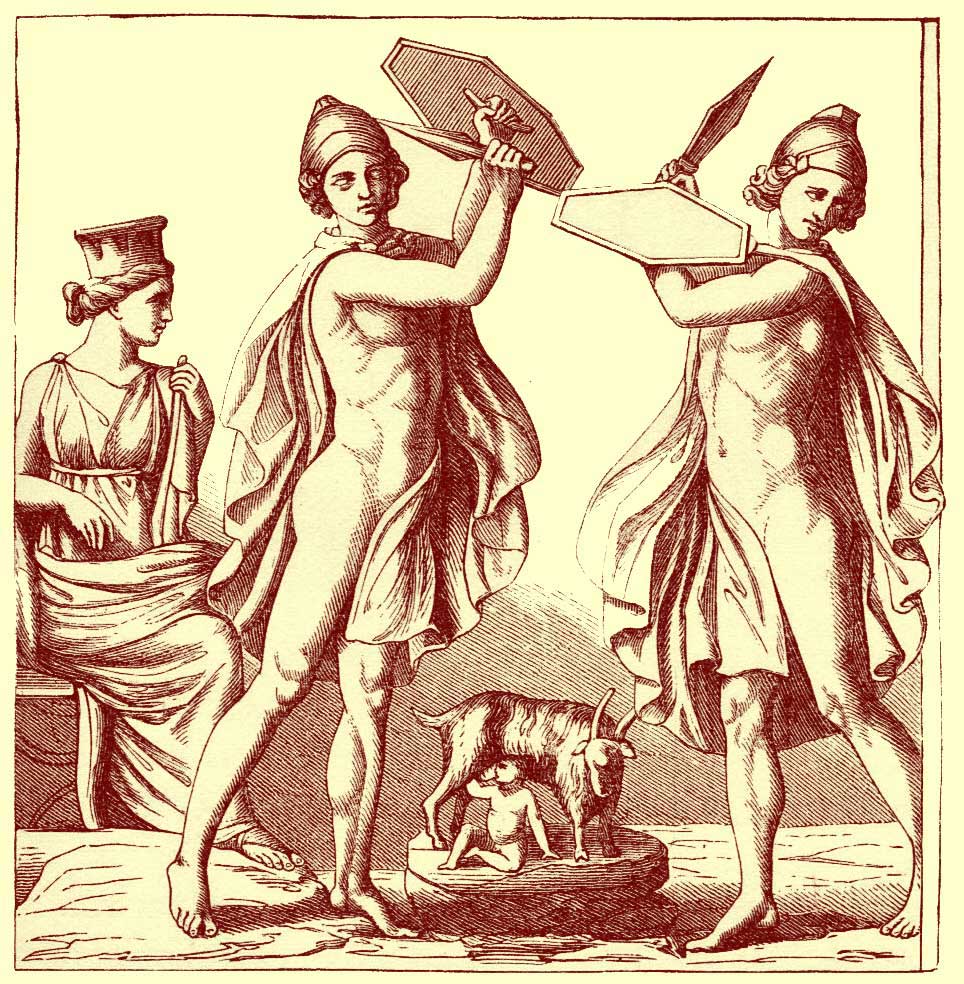![Black and white illustration of a relief from the Capitoline Museum in Rome of Cronus, seated, wish a sickle in one hand, and being handed a bundle [the stone] wrapped in strips of cloth by Rhea.](../images/CronusA.jpg)
From Manual of Mythology, by Alexander S. Murray; Revised Edition, Philadelphia: David McKay, Publisher, 1895; pp. 44-48.
44![Black and white illustration of a relief from the Capitoline Museum in Rome of Cronus, seated, wish a sickle in one hand, and being handed a bundle [the stone] wrapped in strips of cloth by Rhea.](../images/CronusA.jpg)
Fig. 1. — Cronus.
“The ripener, the harvest god,” was, as we have already remarked, a son of Uranus. That he continued for a long time to be identified with the Roman deity, Saturnus, is a mistake which recent research has set right, and accordingly we shall devote a separate chapter to each. Uranus, deposed from the throne of the gods, was succeeded by Cronus, who married his own sister Rhea, a daughter of Gæa, who bore him Pluto, Poseidon (Neptune), and Zeus (Jupiter), Hestia (Vesta), Demeter(Ceres), and Hera (Juno). (See Genealogical Table No. 1.) To prevent the fulfilment of a prophecy which had been communicated to him by his 45 parents, that, like his father, he too would be dethroned by his youngest born, Cronus, swallowed his first five children, apparently as each came into the world. But when the sixth child appeared, Rhea, his wife, determined to save it, and succeeded in duping her husband by giving him a stone (perhaps rudely hewn into the figure of an infant) wrapped in swaddling-clothes, which he swallowed, believing he had got rid of another danger.
While the husband was being deceived in this fashion, Zeus, the newly-born child, was conveyed to the island of Crete, and there concealed in a cave on Mount Ida. The nymphs Adrastea and Ida tended and nursed him, the goat Amalthea supplied him with milk, bees gathered honey for 46 him, and in the meantime, lest his infantile cries should reach the ears of Cronus, Rhea’s servants, the Curētes, were appointed to keep up a continual noise and din in the neighborhood by dancing and clashing their swords and shields.

Fig. 2. — Rhea and the Curetes with the Infant Zeus.
When Zeus had grown to manhood he succeeded by the aid of Gæa, or perhaps of Metis, in persuading Cronus to bring back into the light the sons whom he had swallowed and the stone which had been given him in deceit. The stone was placed at Delphi as a memorial for all time. The liberated gods joined their brethren in a league to drive their father from the throne and set Zeus in his place. This was done; but the change of government, though acquiesced in by the principal deities, was not to be brooked by the Titans, who with the exception of Oceanus proceeded to war. The seat of war was Thessaly, with its wild natural features suggestive of a conflict in which huge rocks had been torn from mountain sides and shattered by the violence with which they had been thrown in combat. The party of Zeus had its 47 position on Mount Olympus the Titans on Mount Othrys. The struggle, lasted many years, all the might which the Olympians could bring to bear being useless until, on the advice of Gæa, Zeus set free the Cyclopes and Hecatoncheires, of whom the former fashioned thunderbolts for him, while the latter advanced on his side with force equal to the shock of an earthquake.
“Mountain on mountain, as the Titans erst,
My brethren, scaling the high seat of Jove,
Heaved Pelion upon Ossa’s shoulders broad
In vain emprise.”
LOWELL.
The earth trembled down to lowest Tartarus as Zeus now appeared with his terrible weapon and new allies. Old Chaos thought his hour had come, as form a continuous blaze of thunderbolts the earth took fire and the waters seethed in the sea. The rebels were partly slain or consumed, and partly hurled into deep chasms, with rocks and hills reeling after them, and consigning them to a life beneath the surface of the earth. The cause of Cronus was thus lost for ever, and the right of Zeus to rule established for all time.

Fig. 3. — Zeus.
(Group from the altar-frieze at Pergamum.)
The island of Crete, where civilization appears to have dawned earlier than elsewhere in Greece, and where the story of the secret up-bringing of Zeus was made the most of, was the principal centre of the worship of Cronus. Here, however, and in Attica, as well as in several other districts of Greece, it was less as the grim god who had devoured his children that he was worshipped than as the maturer and ripener, the god of harvest, who sends riches and blessings, prosperity and gladness. So it happened that his festivals in Greece, the Cronia, and the corresponding Saturnalia in Italy, were of that class which imposed no restraint on the mirth and pleasure of those present, and seemed like a reminiscence of an age when under the rule of Cronus there 48 had been a perpetual harvest-time on earth. As the devourer of his children Cronus bears a resemblance to the Phœnician Moloch, and it is highly probable that this phase of his character originated in Crete, where the influence of Phœnician settlers had been felt from very remote times. It is also to be noted that his wife Rhea enjoyed a very early and widespread worship in Asia Minor.